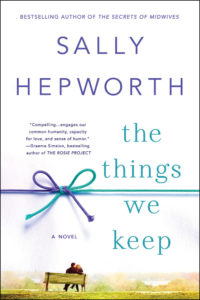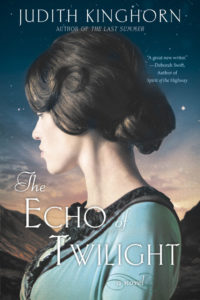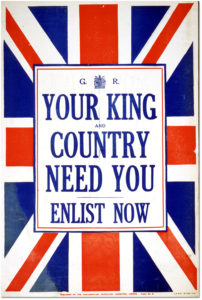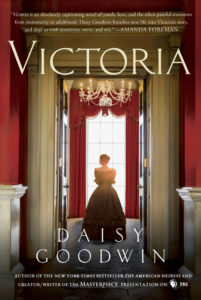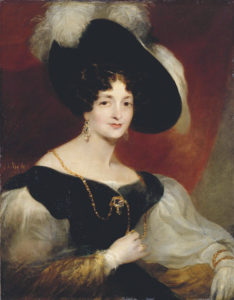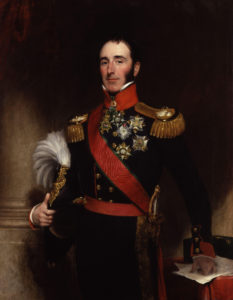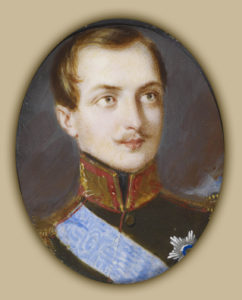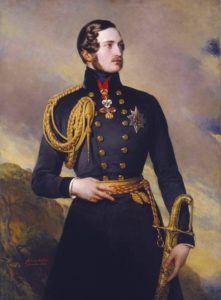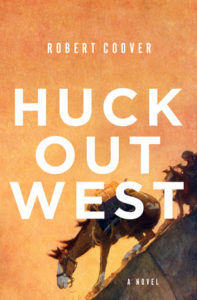 “Wonderfullest” sequel to an American classic (Western and Indian Territories around the start of the Civil War to 1876): It takes boldness and a master to craft an “owdacious” and masterly sequel to a Great American Novel. Huck Out West, Robert Coover’s 11th novel, is just that.
“Wonderfullest” sequel to an American classic (Western and Indian Territories around the start of the Civil War to 1876): It takes boldness and a master to craft an “owdacious” and masterly sequel to a Great American Novel. Huck Out West, Robert Coover’s 11th novel, is just that.
Told through an adult Huck’s eyes in a mostly “melancholical” voice, this collage of adventure tales follows Huck “over a fair number of years and persons” after he declared in The Adventures of Huckleberry Finn he’s “got to light out for the territory” so Aunt Sally can’t “sivilize me.”
Huck Finn is “one of those books everyone knows, even if everyone has not read it,” wrote American Literature professor John Seelye in his introduction to the 2009 Penguin Classics Deluxe Edition. So if like me you’ve “disremembered” Huck’s earlier escapades, take heart for this outstanding novel stands alone.
As a blogger, though, I sampled a ridiculous fraction of the voluminous critical analyses of the essence of Mark Twain and his masterwork – influence, language, themes, inventiveness – to have some basis for judging the cleverness of Coover’s sequel.
For I was at a disadvantage. I’d not read any of the author’s extensive body of work, unaware of Robert Coover’s “reckonition.” Professor Emeritus of Literary Arts at Brown University is “widely acknowledged as an innovator in the field of post-modern American fiction.”
Plainly, I don’t profess to be a scholar of either author. You don’t have to be to relish what Coover has achieved.
Before introducing a bit of what Huck Finn gets mixed up in, here’s some things that may surprise. For starters, Huck Out West is a wickedly disguised series of serious history lessons in America’s westward expansion. If you’re not an historian, you’ll recognize many historical references, but perhaps not all.
Another surprise is the timelessness of Twain’s social commentary. Huck was invented in 1876 but his moral code is as relevant today as ever. That’s because Huck Out West hits at the core of human nature. Huck’s moral compass still prevails. “It’s not easy to stand up for something when you’re the only one,” says Ben Harper, one of Huck’s childhood friends who periodically pops in, stays for a brief while. (Tom, Jim, and Becky make appearances too.)
The prose is an unexpected joy. The Adventures of Huckleberry Finn takes place in the pre-Civil War slavery era. Thus the controversy over its offensive, prolific use of the “n” word as Twain, like postmodernists, sought “trueness.” By my count, the repugnant historical word appears twice in Huck Out West. Given the sequel’s Civil War and post-Civil War setting, the language (and hideous actions) illuminates racism towards a different population: Native Americans. And, it continues to reflect Huck’s poor Missouri education, filled with bad (and humorous) grammatical usage – a few examples herein – as well as regional southern dialect, as Missouri was considered part of the South back then.
The concept of time is fuzzy. The novel doesn’t begin at the beginning. It kicks off someplace in the middle when Huck has spent “many seasons” in the territories. Timelines help put context to the historical events. What year is this? Along the way, Coover provides clues as to the novel’s timespan: Huck’s a rider for the Pony Express, legendary but it only lasted from 1860-1861; Huck hears the President was shot (1865); the ending falls around the centennial celebration of Independence Day, 1876. Presumably then, Huck Out West opens in the middle of these years, 1870? But try as I might I couldn’t pinpoint Huck’s precise age, a desire triggered in part by Huck’s telling us on page one that he “spent nigh half his life out West.” The novel is referred to as “iconoclastic,” which I learned includes this kind of disordered chronology called fragmentation. Suffice it to say Huck’s now a grown-up!
Not according to Tom Sawyer. Tom tells Huck his problem is he’s “still living in a dream world that don’t exist.” Cheers for Huck if that means he didn’t turn out like Tom, someone who “loved a good hanging” and wasn’t “scrupulous about consequences.” Huck rails against the “grabby emigrants” who came west searching for fortunes; sadly Tom has become one of them. Huck’s rallying cry is against the “meanness of the whole human race.” This was the Wild West, when “awful things had happened.”
Not everything is harrowing. Huck’s atypical attitude toward American Indians, particularly the Lakota Sioux of today’s South Dakota, is a highlight. That doesn’t mean he fully understood the plains Indians for there was a stint when he killed buffalo, until he learned the tragedy it was.
The novel opens in the middle for good reason. Huck’s been bitten by a poisonous snake, saved by the Lakotas, leading to a “proper friend,” Eeteh. Eeteh’s plight humanizes the Indian Wars. Huck lives among the Lakotas for the cited “many seasons.” In fact, his teepee is the closest he comes to feeling he has a real home. With Eeteh, he delights in “jawing,” drinking whiskey, smoking a stone pipe, and listening to the myths of the Great Spirits. Eeteh is different than his tribe, so the two share an outsider connection. A peaceful fellow who revels in laughter, he contrasts with the Sioux known as relentless fighters – Crazy Horse and Sitting Bull show up too.
The Adventures of Huckleberry Finn is set in a fictional town, St. Petersburg, based on Hannibal, Missouri, where Samuel Langhorne Clemens grew up. Similarly, in Huck Out West, a principal town is Deadwood Gulch (in today’s Nevada), drawing from Twain’s travels to Nevada Territory with his brother in the 1860s. He lived in Nevada for a stretch, reminding me to tell you that while the novel paints realities, some “stretchers” are thrown in too. (Mostly, they’re Tom’s.)
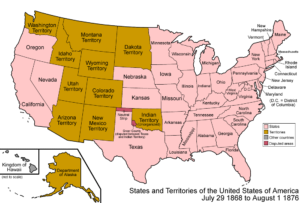
United States, 1868-1876
Via Wikimedia Commons, by User:Golbez. (Own work) [GFDL, CC-BY-SA-3.0 or CC BY 2.5]
As far as Huck’s concerned, the discovery of gold is “bad-luck.” What’s “importantest” to him, makes him “comfortabler” is comradery, Nature, and a deep bond with horses. His attachment to two – old Jackson and Tongo a wild stallion he gentles – touch us. Breakaway scenes of Huck riding bareback across the landscape on this powerhouse horse no one else dare ride are stirring imagery. So is Huck’s brave act to rescue a herd of Indian horses seized by a mean-spirited Cavalry General – abuse/escapism/freedom, a running theme.
Huck’s “bad luck” comes when he refuses to do what “General Hard Ass” demands he do. (He’s worked a spell for both the North and South sides of the Army.) No surprise Huck’s not a “good soldier” for he’s got a mind of his own. Huck is forever fleeing the General, one of my history lessons: The General is fashioned on General George Armstrong Custer who led the Black Hills Gold Rush portrayed in the novel. (It ended in 1876, another indicator of the novel’s timespan.)
The romantic elements of the Old West are here too. Huck’s a bona fide cowboy. He wrangles horses, protects wagon trains and stagecoaches, and drives cattle over the famed Chisholm Trail along a desert “as lonely and as sad as me.”
Huck warns “life don’t rarely turn out like you think it might.” True, but it’s “sejested” you come along for this “jeanie-logical” ride anyway. It’s one heck of a journey. Or, as Huck would say, “heck-stasy.”
Lorraine

